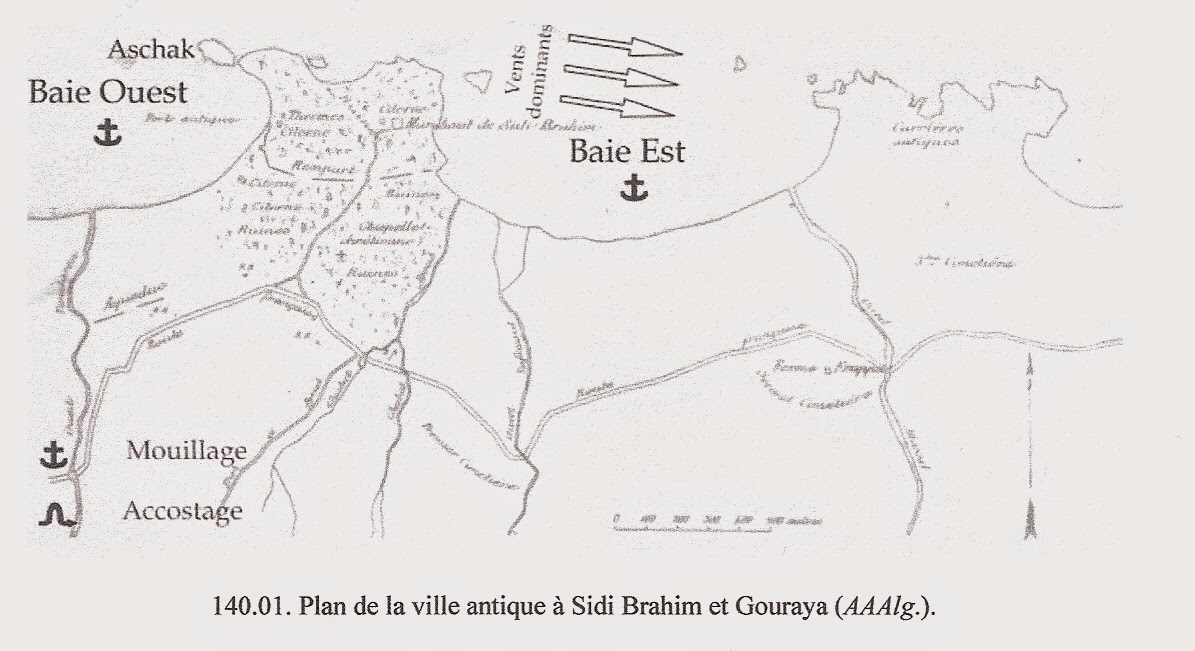CAZAZA
This place
near Sidi Messaoud on the west-flank of the peninsula Tres Forcas was indicated
by César Luis de Montalban on his map from 1932 as a finding place of
Phoenician/Punic findings. There was no further specification available. Also R.Fernandez de Castro mentions the
place in 1943 in the publication: “Historia y exploracion de las ruinas de
Cazaza, villa del antiguo reino de Fez, emplazada en la costa occidental de la
Peninsula de Tres Forcas. » Enrique Gozalbes Cravioto presents with his
study: “Algunes Avatares de la Arqueologia colonial en el norte de Marruecos
(1939-1942) ». A
study on the organisation of archaeology in the North of Morroco between the
years 1939-42 as well as some incidences in the development of the same one.
Also in the work the archaeological discoveries that are analyzed at the same
time they became in Tanger. Still there are no specific references to
Phoenician or Punic findings. Finally we find the publication of again Enrique
Gozalbes Cravioto : “Notas sobre Cazaza, Puerto de Fez y Fortaleza
Espanola (1506-1533)” Cazaza was a
medieval city that, during some thirty years in the XVI century, was occupied
by the Spaniards. In this article he studied and interpreted the archaeological
vestiges and add new data for their knowledge drawn from documentation not used
until that time. Gozalbes speaks now only of a medieval city. After 1944 it
seems that there were no further excavations.
I have a problem
now, because there is the allegation of Montalban that there were Phoenician
and Punic findings done, but later there comes no confirmation whatsoever! Luckily
Enrique Gozalbes Cravioto (must be very old by now!) was willing to give an
explanation, which I received yesterday:
“Hello, good afternoon, Mr. Henk van Diessen. I
hope to answer as precisely as possible to your question. CL Montalbán explored
the ruins of Cazaza in 1929. In its report noted the appearance of "Punic
and Roman pottery" in a certain amount. What Montalbán understood by Punic
pottery? The distinction between the Punic and Roman layers was undoubtedly
evident to him because he had dug in deep layers of Lixus, but I'm not entirely
sure.
Yes it is entirely true that in later works,
from the forties, the appearance of Campanian pottery and Roman sigillata reflected
and Spanish coins minted at least in the first century BC. On my visit there
many years ago I observed the presence of fragments most likely common Roman
pottery, as well as three fragments of Roman sigillata. Thus, the presence of
occupation is undeniable since the first century BC. A former presence is plausible, but nothing is
certain. Montalbán did not invent data, but could have made mistakes, and therefore
we should be cautious about their findings.
I hope this answer will be useful.
Yours sincerely”
I hope I
translated the Spanish from Gozalbes to decent English, but his view is clear.
There was a Roman settlement in the 1st century BC at Cazaza. The
findings of Montalban must be treated cautious. So we are not sure of a
Phoenician or Punic settlement at Cazaza. However, after 1944 there was no
thorough excavation done. Still much work to do here.
The
distance between Melilla











































